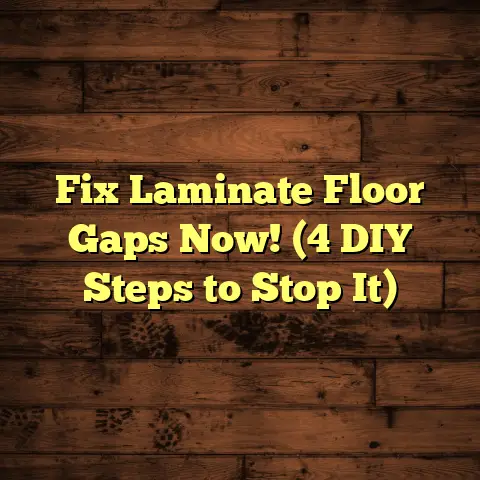Care For Calacatta Gold Tiles (3 Grout Killers!)
There’s nothing quite like the feeling of walking into a room adorned with Calacatta Gold tiles.
The luxurious veining, the warm, inviting undertones… it’s pure elegance. I’ve seen firsthand how these tiles transform kitchens, bathrooms, and living areas into stunning showpieces.
The smooth, cool surface underfoot adds a touch of comfort and sophistication that’s hard to beat.
But let’s be honest, keeping these beauties pristine, especially the grout, can be a challenge. That’s why I’m here to share my expertise on how to protect your investment and keep your Calacatta Gold tiles looking their absolute best, focusing on the sneaky “grout killers” that can ruin your tile’s appearance.
Section 1: Understanding Calacatta Gold Tiles
What Are Calacatta Gold Tiles?
Okay, let’s get down to brass tacks. Calacatta Gold is a type of marble quarried in the Carrara region of Italy.
Think of it as the VIP of the marble world. What sets it apart? Those distinctive, bold gold and grey veining patterns against a bright white background.
This makes it a highly sought-after material for high-end interior design projects.
Compared to other marbles like Carrara (which has softer, more subtle veining) or Statuario (known for its pure white base), Calacatta Gold offers a bolder, more dramatic statement.
Homeowners choose it because it instantly elevates a space, adding a touch of luxury and timeless beauty. I’ve seen it used in everything from kitchen backsplashes to grand bathroom floors, and it always makes a statement.
The Importance of Grout in Tile Installation
Now, let’s talk grout. It’s easy to overlook, but grout is the unsung hero (or villain, if neglected!) of any tile installation.
It acts as the binder, holding your precious Calacatta Gold tiles in place. But it’s more than just functional.
Grout lines define the overall look of your tiled surface. Think of it like the frame around a masterpiece.
The color, width, and even the type of grout you choose can drastically impact the finished product.
However, grout can also be a real pain point. It’s porous, making it susceptible to staining, discoloration, and the dreaded mold and mildew.
And because Calacatta Gold tiles are so visually striking, any imperfections in the grout become even more noticeable.
Trust me, I’ve seen projects where dull, stained grout completely detracts from the beauty of the tile itself.
That’s why proper grout care is absolutely crucial for maintaining the overall aesthetic and longevity of your Calacatta Gold investment.
Section 2: The Three Grout Killers
Alright, buckle up! We’re diving into the three main culprits that can wreak havoc on your grout and, by extension, your gorgeous Calacatta Gold tiles.
Knowing these “grout killers” is half the battle.
-
Moisture and Water Damage
Water. It’s essential for life, but it can be a nightmare for your grout.
Here’s the deal: Grout is porous. This means it acts like a sponge, readily absorbing water and any dissolved substances it carries.
When water seeps into grout lines, it creates the perfect breeding ground for mold and mildew. I’m talking about those unsightly black or green spots that can appear seemingly overnight.
But the problems don’t stop there.
Over time, constant exposure to moisture can weaken the structural integrity of the grout. It can lead to cracking, crumbling, and even detachment from the tile edges.
This not only looks awful but can also compromise the stability of your entire tile installation.
Think about your bathroom shower. It’s a prime example of a high-moisture environment.
According to the EPA, indoor humidity levels should be kept between 30-50% to prevent mold growth. (Source: EPA website on mold)
But even with proper ventilation, water can still penetrate the grout lines, especially if the grout wasn’t sealed properly in the first place.
Other common sources of moisture include:
- Leaky faucets and showerheads
- Spills that aren’t cleaned up promptly
- Poorly ventilated areas, like basements or crawl spaces
I’ve seen cases where hidden leaks behind walls or under floors caused extensive mold and grout damage before the homeowner even realized there was a problem.
How to spot the signs:
- Discoloration of the grout (darkening or staining)
- Visible mold or mildew growth
- Cracking or crumbling grout
- A musty odor in the room
-
Harsh Cleaning Products
Listen, I get it. You want to keep your Calacatta Gold tiles sparkling clean. But reaching for the strongest cleaner you can find is a huge mistake.
Many popular cleaning products contain harsh chemicals, like acids (such as hydrochloric or sulfuric acid) or abrasive particles, that can erode grout over time.
Think of it like this: You’re essentially dissolving the grout a little bit each time you use these cleaners.
Acidic cleaners can etch the surface of the grout, making it more porous and susceptible to staining.
Abrasive cleaners, on the other hand, can scratch and dull the finish. And guess what? These scratches create even more nooks and crannies for dirt and grime to accumulate.
It’s a vicious cycle!
Even seemingly “gentle” cleaning products can be harmful if used incorrectly. For example, using too much bleach can weaken the grout and cause it to crumble.
And don’t even get me started on using steel wool or hard-bristle brushes to scrub grout lines. These tools are way too abrasive and will almost certainly damage both the grout and the tile surface.
I’ve seen homeowners unknowingly ruin their grout by using the wrong cleaning products. It’s a costly mistake that can easily be avoided.
According to the National Association of Home Builders, using appropriate cleaning products can extend the life of your tile installation by up to 50%. (Source: NAHB website)
The Chemistry Lesson (Simplified):
- Acids: These have a low pH and react with the alkaline components of grout (like cement), dissolving them.
- Abrasives: These physically wear down the grout surface, creating microscopic scratches.
- Bleach: While effective at killing mold, excessive use can weaken the grout structure and fade its color.
-
Improper Sealing and Maintenance
This is where many homeowners drop the ball. Sealing your grout is absolutely essential for protecting it from stains, water damage, and general deterioration.
Think of grout sealer as a protective shield that repels water and prevents dirt and grime from penetrating the porous surface.
Without sealer, your grout is basically defenseless against the elements.
Sealing grout is especially important for Calacatta Gold tiles because the bright white background highlights any imperfections in the grout.
If your grout isn’t sealed, even a small spill can leave a permanent stain that’s nearly impossible to remove.
But here’s the catch: Sealer doesn’t last forever. Over time, it wears down from foot traffic, cleaning, and general wear and tear.
The frequency with which you need to reseal your grout depends on several factors, including the type of sealer used, the amount of traffic the area receives, and the type of cleaning products you use.
As a general rule of thumb, I recommend resealing grout every 1-2 years in high-traffic areas like bathrooms and kitchens.
However, it’s important to inspect your grout regularly and look for signs that it needs to be resealed.
Signs Your Grout Needs Resealing:
- Water no longer beads up on the grout surface.
- The grout darkens quickly when exposed to water.
- Stains are becoming more difficult to remove.
Section 3: Care and Maintenance Tips for Calacatta Gold Tiles
Okay, now for the good stuff! Let’s talk about how to keep your Calacatta Gold tiles and grout looking their absolute best.
These tips are based on years of experience and will help you avoid those dreaded “grout killers.”
Daily and Weekly Cleaning Routines
Consistency is key when it comes to cleaning Calacatta Gold tiles. A little bit of regular maintenance goes a long way.
Daily:
- Sweep or vacuum: Remove any loose dirt, dust, or debris from the tile surface. This prevents it from being ground into the grout lines.
- Wipe up spills immediately: Don’t let spills sit on the tile surface, especially acidic substances like coffee, wine, or juice.
Weekly:
-
Mop with a pH-neutral cleaner: Use a cleaner specifically designed for natural stone or tile. Avoid anything acidic or abrasive.
I personally recommend using a solution of mild dish soap and warm water. It’s gentle yet effective at removing everyday dirt and grime.
Important: Always rinse the tile surface thoroughly with clean water after mopping to remove any soap residue.
Suitable Cleaning Products:
| Product Type | Ingredients to Avoid | Recommended Alternatives |
|---|---|---|
| Daily Cleaner | Acids (Vinegar, Lemon), Abrasives (Scrubbing Powders) | pH-Neutral Stone Cleaner, Mild Dish Soap |
| Grout Cleaner | Bleach (Excessive), Strong Chemicals | Baking Soda Paste, Hydrogen Peroxide |
| Sealer | Solvent-Based Sealers | Water-Based Penetrating Sealers |
Deep Cleaning Techniques
Sometimes, a little extra elbow grease is needed to tackle stubborn stains or discoloration in your grout lines.
Here are a few effective deep cleaning techniques:
-
Baking Soda Paste: Mix baking soda with a little water to form a thick paste. Apply the paste to the grout lines and let it sit for 10-15 minutes. Scrub with a soft-bristled brush (an old toothbrush works great!) and rinse thoroughly with water.
-
Hydrogen Peroxide: For more stubborn stains, try using hydrogen peroxide. Pour it directly onto the grout lines and let it sit for 5-10 minutes. Scrub with a soft-bristled brush and rinse thoroughly with water.
Important: Always test any cleaning solution in an inconspicuous area first to make sure it doesn’t damage the tile or grout.
DIY Grout Cleaning Solutions (Recipe):
- Baking Soda & Water: 1/2 cup baking soda + 1/4 cup water = Paste
- Hydrogen Peroxide & Baking Soda: Paste of baking soda with 3% hydrogen peroxide
- Dish Soap & Warm Water: Few drops of mild dish soap in a bucket of warm water
Preventative Measures
Prevention is always better than cure, especially when it comes to grout care. Here are a few simple strategies to prevent grout damage:
- Use mats in high-traffic areas: Place mats or rugs at entrances and in areas that receive a lot of foot traffic. This will help to trap dirt and debris before it gets ground into the grout lines.
- Promptly clean spills: Don’t let spills sit on the tile surface. Wipe them up immediately with a clean cloth.
- Improve ventilation: Ensure proper ventilation in bathrooms and kitchens to reduce moisture buildup. Use exhaust fans during showers and cooking.
- Regular inspections: Inspect your grout regularly for signs of damage, such as cracks, stains, or discoloration. Catching problems early can prevent them from escalating.
- Re-seal your Grout: Depending on usage, re-seal your grout every 1-2 years to maintain its protective barrier.
Conclusion
Calacatta Gold tiles are a beautiful and luxurious addition to any home. But like any investment, they require proper care and maintenance to keep them looking their best.
By understanding the three “grout killers” – moisture, harsh cleaning products, and improper sealing – and following the care tips I’ve shared, you can protect your tiles and enjoy their beauty for years to come.
Remember, a little bit of effort goes a long way when it comes to grout care. With the right maintenance practices, you can keep your Calacatta Gold tiles sparkling clean and prevent costly repairs down the road.
So go ahead, embrace the luxury of Calacatta Gold, and rest assured that you have the knowledge and tools to keep your tiles looking their absolute best!





